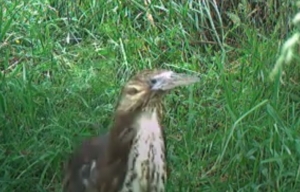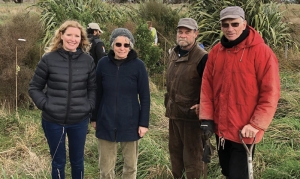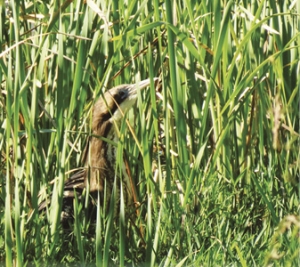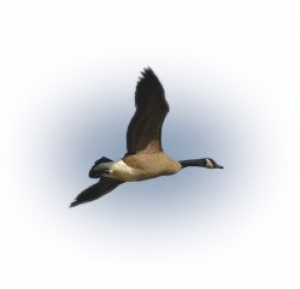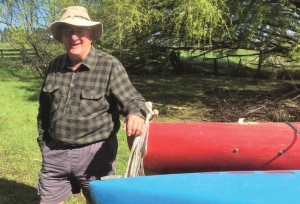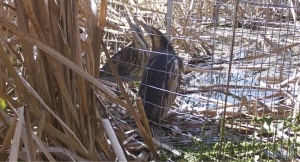Displaying items by tag: Bittern
Elusive Bittern
Elusive Bittern caught on camera at Wairio Wetland
Jessica Wagner is a student at Victoria University of Wellington, researching rat response to scent and acoustic stimuli in the Wairio wetland. The intended outcome of Jessica's research is to determine what stimuli are most attractive to rats in order to improve trapping efforts, and ultimately, to protect rare birds such as the Bittern and wetlands in general.
Jessica was a recipient of one of the wetland care scholarships.
"I was recently going through my footage and noticed that one of my cameras has recorded a video of a Bittern on the 4th of December! I thought that you and others at Ducks Unlimited NZ may be interested in this so I have attached the video below. Feel free to share with anyone else who may be interested" (Jessica) .
2022 Wairarapa Moana annual spring matuku and spotless crake survey
First recorded booming within the DU Wairio wetland
The spring 2022 survey report compiled by Shane Cotter, a contractor engaged by GWRC.
John Cheyne of Wetlands Works led annual spring surveys for Australasian bittern (matuku, Botaurus poiciloptilus) and spotless crake (pūweto, Zapornia tabuensis) at selected wetlands within Wairarapa Moana between 2012 and 2021. In 2022, John passed this responsibility to me. I conducted the annual spring (October-November) 2022 survey using the same methodology as in previous years so continued comparisons could be made of the annual results.
This year’s survey focused on the core wetlands (Boggy Pond, Matthew’s Lagoon and Wairio wetland) and the northern wetlands (Barton’s Lagoon, Tauherenikau delta, Simmond’s Lagoon, JK Donald Block). Only booming male matuku are surveyed because females are much less vocal and therefore very difficult to detect and monitor. This booming call is associated with males attempting to attract females for breeding. Pūweto were also surveyed at Boggy Pond and Matthew’s Lagoon.
In the 2022 survey, 11 booming male matuku were located at the core wetlands and 12 in the northern wetlands. This is an increase in previous years and a record number at both locations. At the core wetlands, numbers have remained relatively stable at 8-9 birds since 2014 while at the northern wetlands, annual numbers of male matuku has varied between 3-9 birds. Overall, the combined number of booming male matuku at the core and northern wetlands has steadily increased from 10 in 2016, to 16 in 2018, to 18 in 2020, and now 23 birds in 2022. In addition to the 23 male matuku heard booming during the 2022 survey, three other birds were seen, one in Matthew’s Lagoon near Boggy Pond and two in Wairio wetland.
At Boggy Pond, nine pūweto were located, the most in Boggy Pond since 2018 and significantly up on the single individual in 2021. At Matthew’s Lagoon, none were recorded during the kayak survey which has been a regular result there since 2014. While undertaking the matuku survey, four other pūweto were heard calling independently, not in response to playback calls. Two were calling in Matthew’s Lagoon close to each other while at two locations within Wairio wetland, one individual was heard calling. I believe there are more pūweto present than recorded during the pūweto surveys. They have just moved to different areas of the wetland complex outside the pūweto survey routes seeking more suitable habitat.
On-going predator trapping with the regular servicing of traps is essential as several predators were seen dead in traps within days of the traps being serviced and rebaited with fresh bait by the trapping contractor at the core wetlands. These included a weasel and several rats. All traps observed were well set up and maintained, and had good vegetation clearance.
Follow the 'read more' link to view the survey report.
Kimi's special high country mission
Kimi, the world's only bittern dog, recently took a break from her usual job of looking for bitterns to take on a special role for her best friend, DU Director Emma Williams. She was to be ring bearer at Emma and bat expert Colin O'Donnell's wedding.
The couple were married on 3 January at Criffen Station, a high country station in Wanaka. We assume bitterns and bats are regular breakfast conversations for the newlyweds.
Congratulations Emma and Colin.
Bittern steals the show
Ducks Unlimited recently received a substantial donation to put towards its restoration work at Wairio Wetland.
Janet and Patrick Velvin, who live in South Wairarapa, are passionate about conservation, particularly water conservation, and contacted The Gift Trust, a philanthropic advisory service, to identify suitable causes they could support.
Cheryl Spain, executive director of The Gift Trust, said they had been impressed with the research on Wairio and DU’s partnerships with the Department of Conservation, Greater Wellington Regional Council and Victoria University, particularly its links with the student research projects at Wairio, and had chosen Wairio as a suitable recipient.
The Velvins visited the wetland for the first time and took part in a planting day with Victoria Uni students in early July.
After helping with the planting, they were given a guided side-by-side tour by Ross Cottle, who identified a suitable site on a promontory for a viewing hide, which could be constructed with some of the funds donated by the Velvins.
During the tour, Patrick asked if there were bitterns in the wetland, and as if on cue, a bittern obliged and flew in front of the them.
Janet became aware of the work at Wairio Wetland through the book Wairarapa Moana: The Lake and its People.
Janet said after the tour they were impressed with Ducks Unlimited and happy to give a donation towards the work at Wairio.
The Bitterns are a Booming
Bitterns are an iconic wetland bird which is becoming increasingly rare through wetland loss and predation by mammalian predators.
They are the apex avian predator in many wetlands and their presence gives an indication of overall wetland condition and health.
I was fortunate that Greater Wellington Regional Council engaged me last year through my small wetland consultancy WetlandWorks to carry out wetland bird surveys on a number of wetlands on the eastern side of Lake Wairarapa. This included Boggy Pond, Mathews Lagoon, Wairio wetland, JK Donald Block and Bartons Lagoon.
Each trip was 8-10 days duration and we based ourselves at Kilmore Lodge, a great home away from home owned by Wellington Fish and Game. One of my recommendations to the Council was the need to carry out a bittern survey of all wetlands around the lake to get a good handle on the population and what threats each site was subject to.
The survey, carried out over two weeks in October and November 2013, focused on locating male bittern who in spring advertise their presence by making a booming call much like a fog horn. They establish territories in mainly dense raupo and use this call to advertise their presence to available females and make other males aware not to come near. The main calling periods are one hour either side of sunrise and sunset. Occasionally they boom all night and all day when there is plenty of action on. This requires regular early starts and late finishes for the bittern counters.
During the survey 20 male bittern were recorded booming and their territories plotted on a map. Seventeen of the booming birds were calling from patches of raupo and the other three from scattered wet patches of oioi (jointed rush), closer to the eastern lake edge.
The main concentrations were around five key sites: Boggy/Mathews/Wairio, Ponui Lagoon, Barrage Gates, south Donald/Mangatete Stream and Bartons/Tauherenikau River mouth.
While bittern are polygamous and males can attract more than one female to their territory, some males are unsuccessful at attracting any. Other studies indicate the sex ratio is about 1:1 so the total population for Wairarapa Moana and associated wetlands is around 40 birds. A report is currently being prepared for Greater Wellington Regional Council that will discuss how these wetlands can be better managed for bittern.
Bittern Workshop
A “meeting of the minds” for people working on bittern was held at Kilmore Lodge, Boggy Pond, Wairarapa on November 2 last year. This was attended by the DOC bittern scientist from Christchurch, other DOC staff, a university student doing a doctorate on bittern, and Greater Wellington Regional Council staff.
This was followed by a get together of local people and landowners interested in bittern around Wairarapa Moana. About 25 people overall.
The presentations and discussions that followed focused on the biology of bittern, habitat use and threats from plant and animal pests and was followed by a short trip to the Boggy Pond car park where everyone heard three of the local male bittern booming and advertising their wares.
A great opportunity for everyone to share information on this threatened but still keystone wetland bird.
John Cheyne
Winter shorebird survey
Winter shorebird survey results at Lake Wairarapa
species counts.
is exceedingly unusual for this site. Red-billed gulls are extremely rare visitors to Lake Wairarapa, having been reported only a handful of times previously (11 birds in February 1948, “irregularly” between 1982-1983, 2 birds in April 1992 and 1 bird in February 2012).
Feral Goose
74
38
15
2174
years. A number of species appear to have increased in abundance over the intervening time, among them NZ dabchick, black shag, little black shag, little shag, black-fronted dotterel and black billed gull. A smaller number of species appeared to have declined in abundance over the same period, including SI pied oystercatcher, pied stilt and spur-winged plover.
1985-1994
2011-2014
to allow them to detect future changes and to re-examine the relationship between shorebird abundance and water levels). You might be interested to know the data from these surveys have recently been put to a variety of other
uses, including:
• To provide quantitative evidence in support of an application to have the Wairarapa Moana wetlands recognised as a “wetland of international importance” under the Ramsar Convention.
• To provide evidence to support the Wairarapa Moana Wetlands (together with
the Ruamahanga River) being listed as an “Important Bird Area” under Birdlife
International’s global IBA programme.
• To form part of our flood protection department’s programme for monitoring
the health of riverbed-dependent bird populations on rivers affected by flood
protection activities (large proportions of the regional populations of several riverbed-dependent bird species overwinter at Lake Wairarapa).
• To provide regional population estimates for a number of shorebird species used for the development of a regional threat classification system for birds of the Wellington Region.
• And lastly, data collected during these surveys are combined with data compiled from other key shorebird sites around NZ to provide estimates of the national population sizes of a number of NZ’s shorebird species. These national
population estimates are in turn put to a variety of uses, including a regular review of national threat classification rankings and ongoing monitoring of the population health of Arctic-breeding migrants using the East Asian/Australasian Flyway, a major avian migration route stretching from Alaska and Siberia in the north to NZ and Australia in the south.
Nikki McArthur
Environmental Scientist
Greater Wellington Regional Council
Trans-Tasman bittern knowledge exchange
Australian wildlife ecologist and bittern expert Matt Herring visited last year and took the time to catch up with his New Zealand counterparts.
“The best thing we can do for nature is simply spend more time in it. From there, reverence grows and action flows.” M Herring, 2013
What a wonderful trip. It was as if we spent a week compiling precious pieces of a rare, incomplete jigsaw puzzle called “Australasian Bittern Ecology and Conservation”.
After several years of being in touch via email and phone, it was so nice to finally get together with the New Zealand bittern crew and see some of their sites first hand.
There is some great work happening across the ditch and a strong sense of being united in working towards reversing the decline of this iconic waterbird that we share. It is affectionately known as matuku hūrepo in Māori, or matuku for short.
The knowledge exchange began with the biennial National Wetland Restoration Symposium in Napier where I was honoured to be a keynote speaker, focusing on the importance of community engagement, novel habitats and active management.
We then had a day visiting wetlands around Hawke’s Bay, including Pekapeka Swamp, followed by a successful bittern workshop day organised by Matt Brady from DOC. It was now crystal clear to me that there’s a lot of love for matuku in New Zealand.
With much discussion about wetland restoration targeting bitterns, it was astounding for many folk to learn about bitterns in rice and how bare, ploughed paddocks ready for sowing are able to support nesting bitterns less than three months later. There was a range of inspiring case studies from around New Zealand at the workshop, and we got to visit some local work in Hawke’s Bay with Hans Rook.
After that, it was time to begin a broader tour of bittern sites across the North Island. First stop was Lake Whatuma, and thanks to John Cheyne and Bernie Kelly, we were able to track some bitterns while kayaking.
We discussed key issues like willow control, raupo (cumbungi) harriers as bittern nest predators.
This wetland has up to nine booming males, but far fewer females, perhaps only three. The apparent shortage of female bitterns across New Zealand is something DOC’s Emma Williams is very concerned about. We may well have the same problem in Australia.
males in rice fields have up to three nesting females in a single territory, there is emerging evidence that would support a general shortage of females here too. It’s definitely something we should consider: a booming male may not be a sufficient indicator of breeding
or site quality.
It was now October and time to visit the 7200-hectare Whangamarino Wetland, between Auckland and Hamilton. This Ramsar site was once the world’s most important wetland for the Australasian bittern, with more than 140 booming males in 1980.
Nowadays, there’s only about a dozen. I learnt about the many issues that are implicated in the decline, such as introduced species and water quality, but I think the huge water level fluctuations are central.
Near Tauranga, we visited the Lower Kaituna Wetland, and were lucky enough to spot a bittern feeding in the eleocharis. Part of the restoration work in the broader area is starting from scratch, essentially constructing new wetlands.
And on the edge of Tauranga itself, right on the coast, we visited a bittern breeding site that was tidal. This was quite perplexing. The vegetation is low and we wondered where they build their nests without being flooded.
Unfledged chicks have been found in land nearby, including a recreational park. We talked about how this site would be suitable for a thermal drone in locating nests and monitoring breeding success.
All in all, a wonderful trip, with special thanks to all who made it possible. I’m looking forward to returning the favour!
The love for matuku in New Zealand is admirable, and the conservation work being done is inspiring
Bittern count reassessed
New research highlights the importance of New Zealand’s wetlands for one of our most secretive native birds, the Australasian bittern or matuku, Conservation Minister Eugenie Sage said on World Wetlands Day, 2 February.
GPS tracking of matuku/bittern has, for the first time, revealed that it flies more than 300km between wetlands in the eastern South Island as well as large distances between North Island wetland sites.
Previously it was thought bittern ranged only small distances from their home wetlands.
DU is one of several partners in the Department of Conservation-led research, which shows that bittern rely on a network of wetlands to feed and breed in.
It also means matuku/bittern may be rarer than previously thought as birds have probably been double-counted in local counts in different parts of the country.
In the study, male bittern were tracked flying 330km from Te Waihora/Lake Ellesmere in Canterbury to wetlands near Blenheim during the breeding season last spring.
They also flew 117km from Whangamarino wetland in north Waikato to south Kaipara and from Whangamarino to Kaituna in the Bay of Plenty.
DU director takes up DOC role
DU director and bittern expert Emma Williams’ workload has become a whole lot busier after she was appointed science advisor (wetland birds) for the Department of Conservation in October.
A fulltime job for four years, her main task is to deliver the national bittern research plan. The role also involves work with other wetland birds such as spotless crakes and marsh crakes with the aim of setting up new collaborations with organisations to try to fill some of the knowledge gaps about cryptic and native wetland birds.
Projects include working with Stephen Hartley and students at Victoria University in Wairarapa Moana. One of the current projects involves putting out artificial bittern nests in several study sites, including Wairio, to determine what predators are targeting bitterns.
Emma says new bittern monitoring projects in South Kaipara, Auckland region, Tauranga and Turangi are expanding DOC’s national monitoring reach. The goal is to identify where bittern strongholds and hot spots are and inform where new projects are needed to try to reverse bittern declines.
The secret life of male bitterns
Finally revealed by DU transmitters

